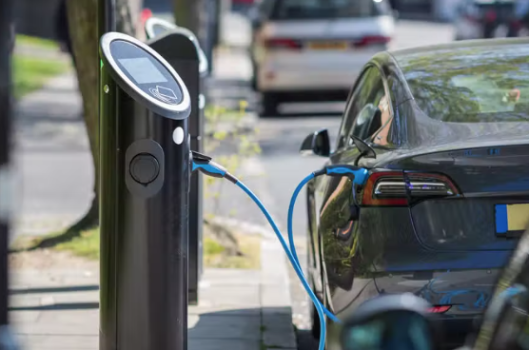Why is the scheme needed?
UK Climate Targets
The Climate Change Act commits the UK government by law to reducing greenhouse gas emissions by at least 100% of 1990 levels (net zero) by 2050.
The environmental impact of climate change is also linked to significant damage to the UK economy. However, combined, the net-zero transition (estimated to cost a maximum of 2% of UK GDP) is expected to have a net benefit of around 4% of GDP (LSE 2022). Addressing climate change will protect and benefit the UK economy as well.
HM Government’s Net Zero Strategy: Build back greener (2021) confirms:
“By 2035 the UK will be powered entirely by clean electricity, subject to security of supply.”
“A low-cost, net zero consistent electricity system is most likely to be composed predominantly of wind and solar generation”
“The net zero economy will be underpinned by cheap clean electricity, made in Britain. A clean, reliable power system is the foundation of a productive net zero economy as we electrify other sectors – so we will fully decarbonise our power system by 2035”.
Energy Security Strategy
The UK’s Energy Security Plan (March 2023) sets out the steps the Government is taking to ensure the UK is more energy independent, secure and resilient. The Plan builds upon the ambitions set out in the British Energy Security Strategy and the Net Zero Strategy.
It identifies the need for five times as much solar PV deployment by 2035.
It recognises that ground-mounted solar is one of the cheapest forms of electricity generation and is very quick to deploy. It can make a significant contribution to the UK meeting its own energy needs.
Government food policy
The UK Government Food Security Report, published in December 2021, is explicit: “The biggest medium to long term risk to the UK’s domestic production comes from climate change and other environmental pressures like soil degradation, water quality and biodiversity.”
The report quantifies this risk, noting that under a medium emissions scenario, climate change could reduce the proportion of ‘Best and Most Versatile’ agricultural land from a baseline of 38.1% to 11.4% by 2050. This would mean a reduction in the UK’s prime agricultural land of almost three quarters.
The Solar Energy UK Briefing confirms that evidence is already available: for example, the drought of 2022 literally caused the potato crop to shrink. Climate change causes crop failure, and solar farms help address climate change. This means solar farms are helping to defend UK and global food supply.
Local targets
- Calling on the UK and Welsh governments to provide the necessary powers and resources to ensure Neath Port Talbot becomes carbon neutral by 2030.
- Publicising the climate emergency.
- Working with relevant experts in research and development in reviewing its current strategies and action plans for addressing climate change.
- Identifying any further necessary policy changes or actions, seeking help from local partners and other research bodies to explain local what local work is already underway, achievements already made and setting targets for the future.
- Updating on further work undertaken by the council in this area on an annual basis.
Why this site?
This application will be supported by a suite of technical reports which will assess the impacts of the development and explain how the scheme can be implemented in a careful and sensitive manner. Indeed, the site is well suited to accommodate the proposed solar farm development as illustrated by the following key points:
- It is located within viable proximity of a connection to the local electricity network
- It is available for the proposed duration of the scheme
- It avoids Best and Most Versatile (BMV) Agricultural Land
- The site is not subject to any designated Landscape (AONB, Green Belt or National Park)
- No designated Heritage Assets including listed buildings, registered parklands and Scheduled Monuments would be effected
- It avoids sensitive ecological designations (SSSI, RAMSAR Sites or Wildlife Reserves)
- Offers an opportunity to deliver substantial ecological enhancements through a Biodiversity Net Gain (BNG)
- It is located away from nearby residential properties to avoid any amenity impacts
- It is located outside of the Flood Zone
- It benefits from a suitable access for construction and maintenance purposes
- It is sufficiently distanced from other solar farm developments (proposed and existing) as to avoid any significant intervisibility between the projects
The site also sits well within the landscape and the existing hedgerows and planting allows for the panels to be accommodated with the site without appearing prominently within the wider landscape.
Decline of centralised fossil fuel power stations and decarbonise the grid
Seven nuclear power stations have been decommissioned in recent years, and all 14 UK coal-fired power stations closed in September 2024. The urgent need for clean renewable generators to reduce carbon emissions is a pressing issue.
Examples of mass decommissioning of fossil fuel power stations are Eggborough and West Burton A. Eggborough, a 2-gigawatt coal-fired generating plant in North Yorkshire, stopped generating in March 2018. West Burton A in Nottinghamshire closed in March 2023. The last coal-fired power station to be operational was Ratcliff on Soar, which closed on 30th September 2024. The urgent need is not only to replace these generators but also to double electricity generation due to demand.
Increase in electricity demand
Electricity demand is set to double by 2050 due to the electrification of the UK including widespread use of heat pumps and electric cars.


The biggest benefit to solar farms is their role in meeting the National Grid’s renewable energy needs. They provide green electricity and reduce reliance on fossil fuels which produce harmful greenhouse gases. Solar technology is a proven source of safe, locally produced, and sustainable power. It is locally produced and secure, with no need for tax payers to subsidise its delivery.
Benefits
Click titles below to view benefits of the scheme.
- Delivers green energy generation that saves 10,750 tonnes of carbon dioxide emissions compared to fossil fuels.
- Can be deployed quickly and removed from the land with minimal impacts when no longer required.
- Allows for agricultural land use and power generation.
- Delivers a net gain in biodiversity through new species rich native planting.
- Will deliver a Community Benefits Scheme that will support locally defined investment priorities.
- Will help deliver on the locally declared Climate Emergency.
- Supports sustainable farm diversification on the farming enterprise.
- Supports energy security and less reliance on importation of fossil fuels.
- Helps create a healthier environment through no air pollution.
It is estimated that this scheme will deliver the following economic benefits:
Construction Benefits
Income towards local businesses
New roles created
Supporting existing businesses
Employees and contractors generated
Operational Benefits
Employment generated over its lifetime for maintenance and operation.
Over £500,000 additional gross added value.
£80,000 per annum business rate income over the life of the project.
*all figures are estimated